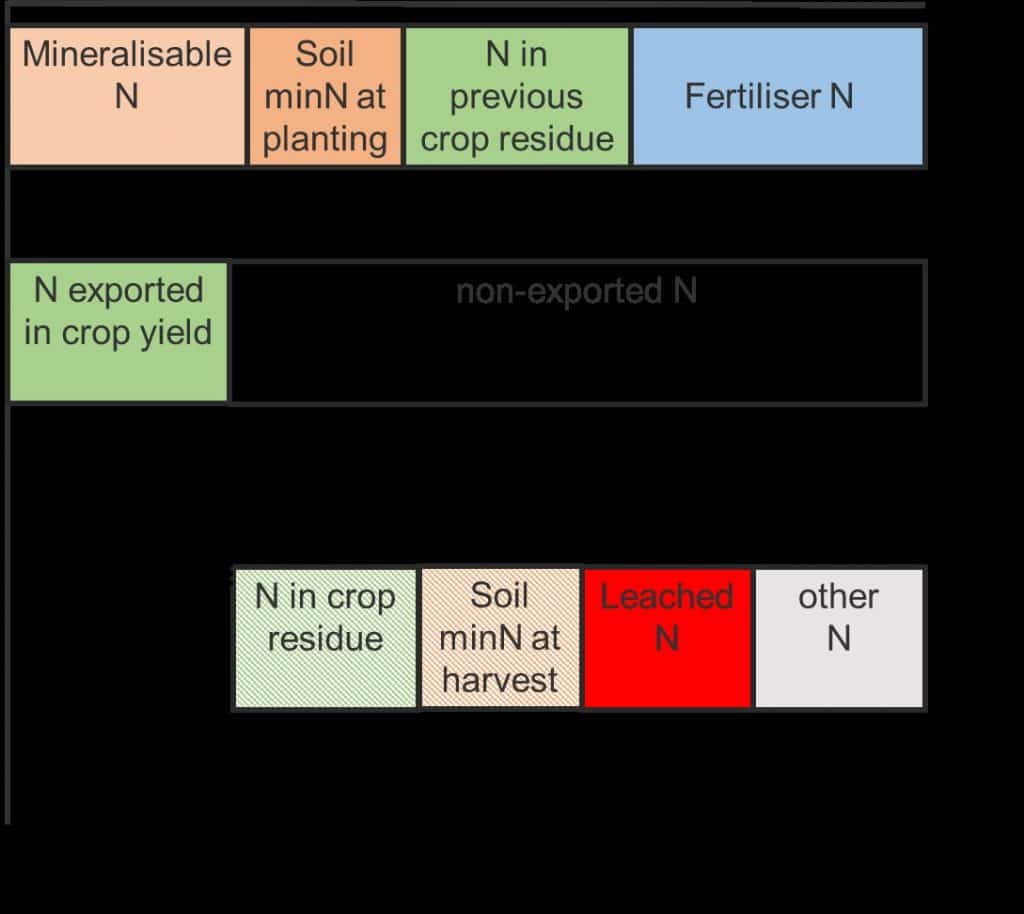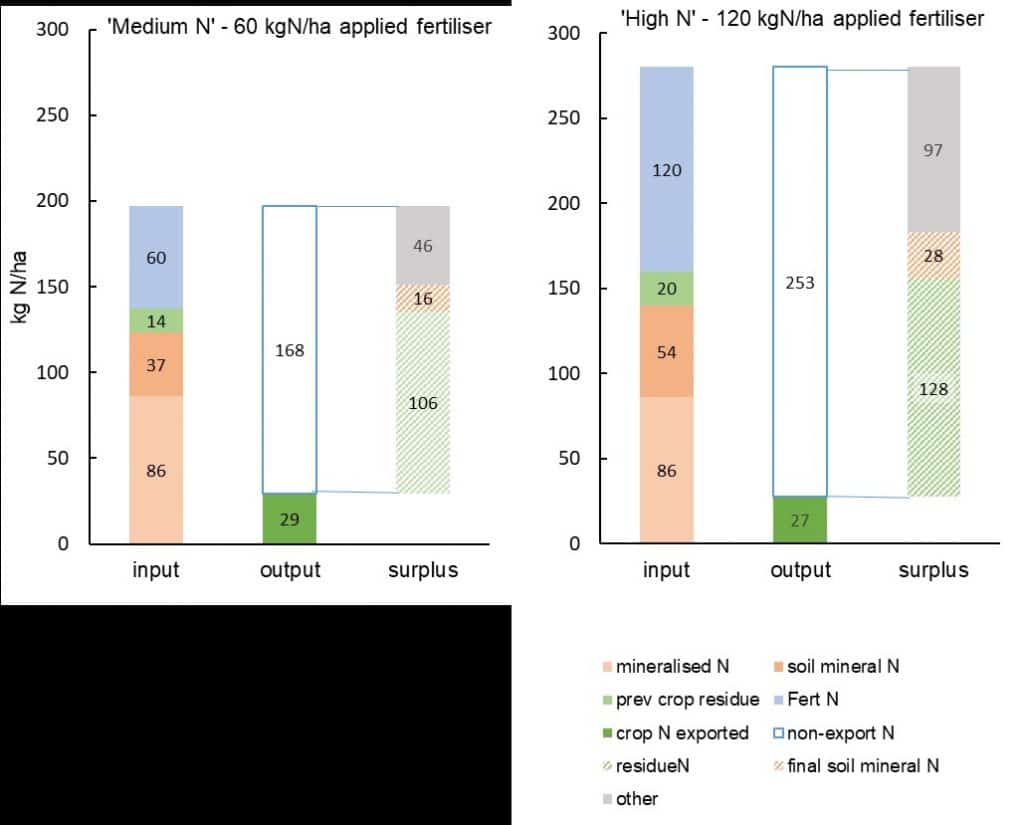Understanding management and environmental implications of nitrogen use in vegetable crop production.
by PFR scientists Bruce Searle, Trish Fraser, & Jo Sharp.
Nitrogen (N) is a key nutrient for the successful production of crops, and each year growers invest significantly in applying N fertilisers. However, not all the applied N is used by the crop – and some can potentially be lost to the environment.
This environmental N loss occurs via different pathways that include leaching (nutrient loss in drainage), runoff, or gaseous losses (via processes known as volatilisation and denitrification). Measurement and monitoring of each individual pathway is complex, and involves having the right equipment and expertise.
In the Sustainable Vegetable System (SVS) project we have developed a method to calculate an N balance to help understand how different production systems and N fertiliser inputs change the amount of N that is potentially at risk for environmental loss (Figure 1).
The N balance is based on the idea that every crop exports a certain amount of N in the sold product. Usually more N needs to be supplied than is exported, which leaves additional N in the system. This N that is not exported becomes part of different pools of N in the crop system where it can be susceptible to loss. Calculating the N balance helps to identify in what pools this ‘non-exported N’ ends up, and helps us better understand N use in the system and the risk of N losses.
An example
We used this approach to calculate the N balance (see Figure 2) for data from broccoli grown in a field experiment as part of the SVS project at the Plant & Food Research farm near Lincoln in Canterbury, with fertiliser application rates of 60 kg N/ha (Medium N) and 120 kg N/ha (High N).
Fertiliser N was applied as calcium ammonium nitrate (CAN) in three equal side-dressings. All other management was the same. The broccoli (cultivar ‘Nobel’) was transplanted on 3 March 2021 and harvested in a single cut on 1 July 2021. Marketable yields were 6.1 t/ha with an application of 60 kg N/ha and 5.5 t/ha with an application of 120 Kg N/ha, with the low yields likely reflecting a single-cut harvest.
To calculate the balance, first we need to determine the inputs and outputs from the system.
The N inputs are:
Mineralisable N– this value was obtained from the Potential Mineral N test (PMN) at transplanting. The results indicate that 86 kg N/ha will be made available to the crops from mineralisation during growth.
Mineral N – the amount of nitrate and ammonium N in the soil that is immediately available to the crop, measured at transplanting. This was 37 kg N/ha for the Medium N treatment and 54 kg N/ha for the High N treatment.
Crop residue N – Stubble from the previous wheat crop was estimated to have provided 14 kg N/ha for the Medium N treatment and 20 kg N/ha for the High N treatment. An assumption is made (for now) that all of the N in the residue becomes available to the crop.
Fertiliser N – the amount of N applied as fertiliser – in this case 60 and 120 kg N/ha.
This gives total inputs of 197 kg N/ha for Crop 1 and 280 kg N/ha for Crop 2.
The N outputs are:
Exported N – the amount of N in marketed broccoli was 29 and 27 kg N/ha for Medium and High N treatments, respectively.
Non-exported N – the difference between the total inputs and exported N was 174 and 253 kg N/ha for Crops 1 and 2, respectively. The non-exported N is the part most susceptible to environmental loss. The question is into what pools of N is the non-exported N allocated? This will have some influence on likelihood of environmental loss. The different pools the non-export N can be allocated to are:
Crop residue N. Most of the non-exported N is in the residue – the stem, leaves and non-marketable broccoli that remain in the field after harvest. This was 106 and 128 kg N/ha for Medium and High N rates, respectively. This will be available for the next crop and should influence subsequent fertiliser application rates.
Soil mineral N left in the soil at crop harvest. The higher this value is, the higher the risk of leaching after harvest. This amount guides the need for a catch crop or care in fertiliser application in subsequent crops. It can also be useful to consider how a certain mineral-N content was arrived at – good use by the crop, leaching in a season, or excess fertiliser application. These amounts were 16 kg N/ha for Medium N and 28 kg N/ha for High N and are not exceptionally high.
‘All Other N’ – referred to as ‘all other’ as it is N in other loss pathways that have not been directly measured (such as leaching, volatilisation or denitrification). The calculated values were 46 and 97 kg N/ha for Medium and High N rates, respectively. As CAN fertiliser was applied and watered in, there is likely to be little loss by volatilisation. Likewise, there was no real flooding due to irrigation or rainfall, so little denitrification. There was, however, a heavy rainfall event in the last three weeks of growth and while it did not lead to flooding in the field, it is likely that a significant portion of this was lost by leaching.
In the SVS project, we are working to obtain improved estimates of how much of the ‘all other’ pool is actually leached from the system as indicated in Figure 1. Knowledge of how the non-exported N is distributed between the different pools of N can influence management. For example, high soil mineral N at harvest would suggest that a very short fallow or catch crops would be useful to limit leaching losses. A high amount of N in residues suggests that fertiliser rates for the subsequent crops should be adjusted to account for this N supply to the crop. Losses via leaching and ‘other N’ (Figure 1) should be used to evaluate in-season management and environmental conditions for those outcomes.
This is a simple framework for an N balance of a field or crop within a field. It provides a check on the sustainability and the potential environmental impacts of N management practices. As more balances are completed and evaluated within the SVS project, this balance will continue to be improved in terms of usability and will provide increased guidance for appropriate management practices. It is one of the tools being developed within the SVS programme for improved sustainable management of N fertiliser.
For any queries on the use of this N balance please contact Andrew Barber (andrew@agrilink.co.nz ) or Bruce Searle (Bruce.Searle@plantandfood.co.nz).

Figure 1. Framework for nitrogen (N) balance. This balance identifies the ‘non-exported N’ (i.e. the N in the system that is over and above that exported in marketable yield) and where the ‘non-exported N’ is allocated within the system. The ‘all other’ pool reflects within season environmental loss, and can be further split into leached and other (gaseous) losses if values can be quantified.

Figure 2. Nitrogen (N) balance for a broccoli crops grown under different N fertiliser rates.



